How to create PowerPoint templates that work
Without a proper PowerPoint template, presentations can be a bit of a mess. Here are the building blocks for developing a PowerPoint template that works!

Video is great for engaging people during a presentation, with something dynamic and emotive, or to provide a clear explanation of a difficult concept. Finding video can be difficult, but there’s a little-known site called YouTube that has a few billion videos to choose from. And you can embed YouTube video in PowerPoint very easily.
The steps for how to embed a YouTube video in PowerPoint, or video from other online sources like Vimeo are pretty simple. It’s a similar process to inserting an offline video into PowerPoint. Go to the Insert tab on the ribbon, then Video on the right-hand side, and choose Online Video. You’ll be asked to enter the URL for the online video, and, as long as it works, a few seconds later you’ll see a thumbnail of the video with a large play icon over it.
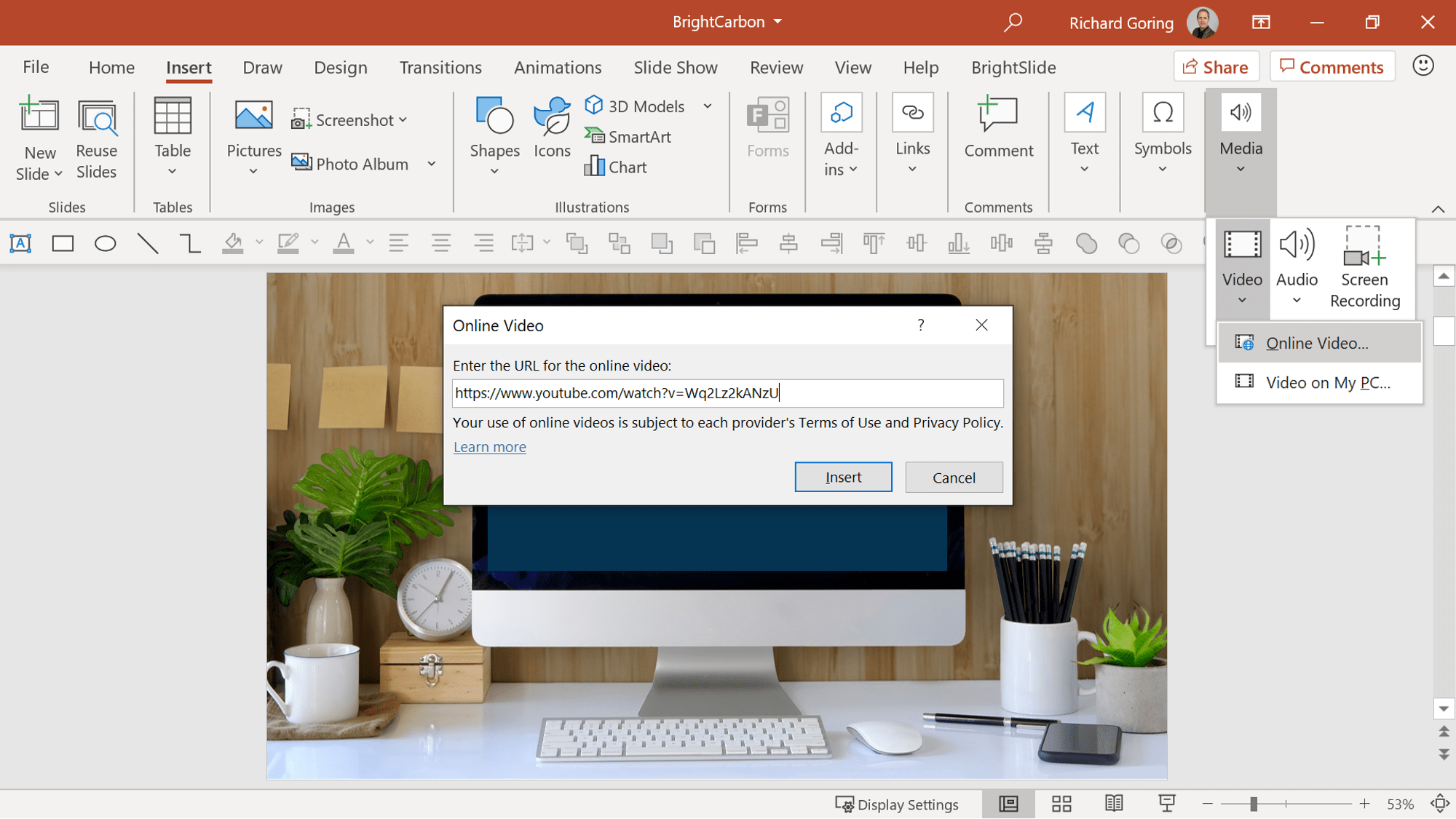
The thumbnail isn’t great quality, and you really notice the pixilation, even when small. In slide show mode you’ll see the pixelated thumbnail and then after a few seconds a crisper version appears, along with the various YouTube video elements around it, like a title, watch later, and share icons, and the familiar YouTube play button in the middle. You can either click that button to make the video play, or use the same animation settings as an embedded video to make it play in the click sequence or automatically, without having to use your mouse.
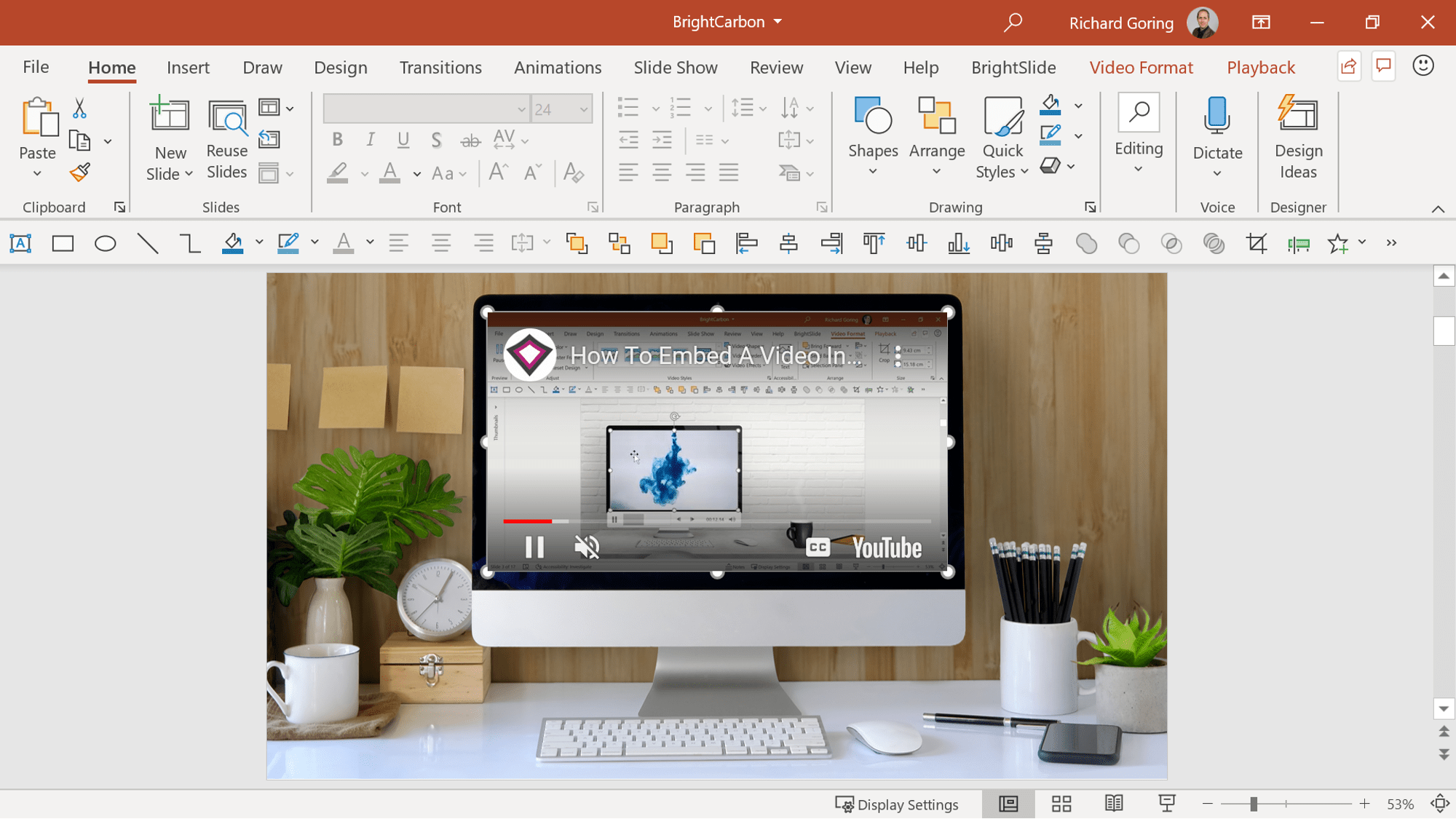
Problems with embedding YouTube video in PowerPoint
Set start time for YouTube video in PowerPoint
YouTube video controls in PowerPoint
Other sources of online video in PowerPoint
Download then embed YouTube video in PowerPoint
How to link a video in PowerPoint
While it looks like you can use the Video Format tab on the ribbon to alter the formatting of the video, don’t be fooled! In the video format tab on the ribbon, most styles you apply will work on the thumbnail, but the video will play in a standard, flat window. Outlines and shadows work, but little else. You can crop the thumbnail, but the entire video will play as large as it can within the crop frame you’ve created. You can change the poster frame, but that only applies to the pixelated thumbnail. As soon as you’re in slide show mode, the thumbnail, or custom poster frame is replaced by the preview of the video with the player controls.
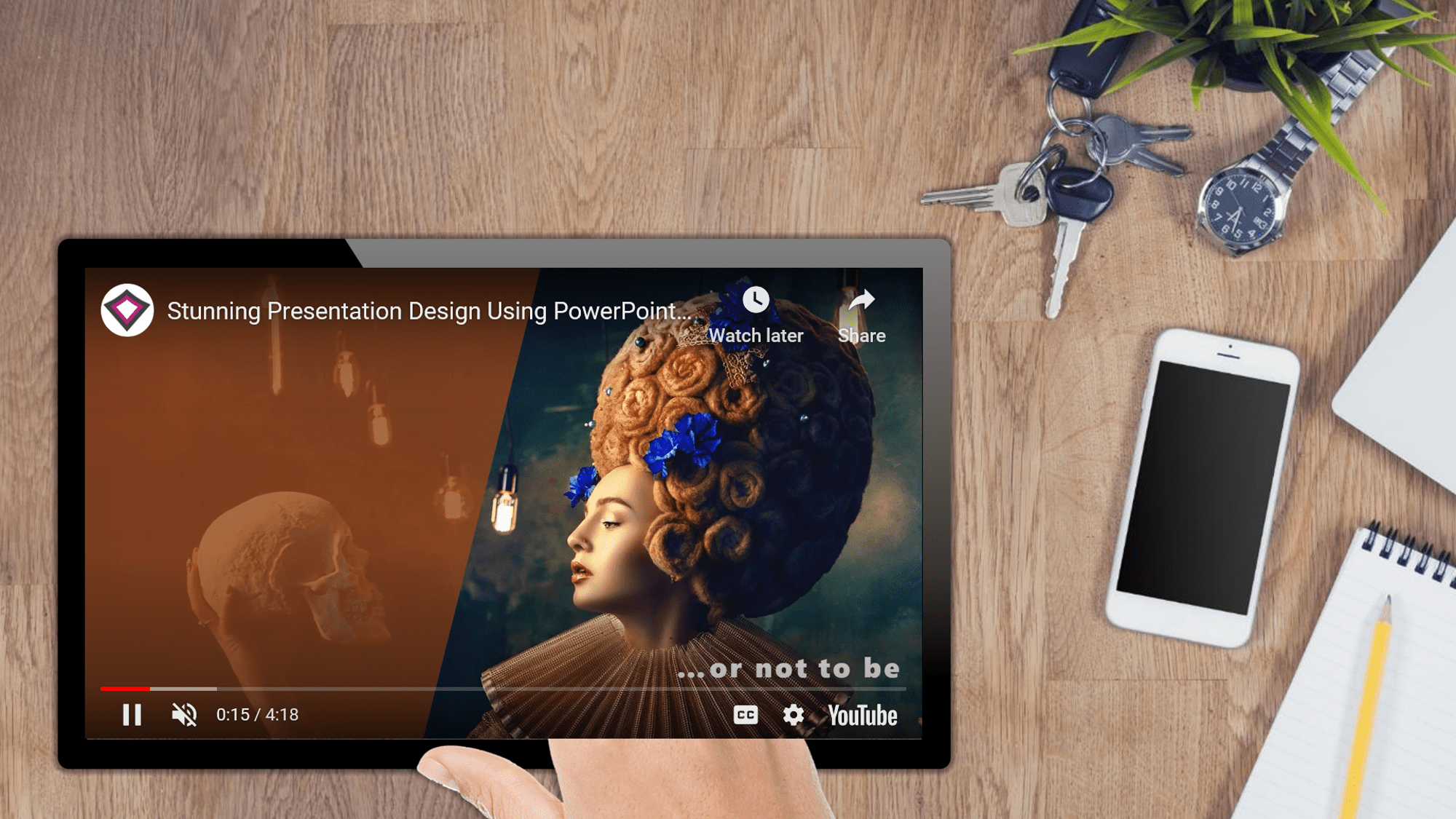
On the Playback tab, you also don’t have the ability to trim the video or make it play full screen. So if you want the video to play full screen you have to ensure that the video frame itself fills the slide. Rather frustratingly, there also appears to be a black line at the edge of some videos while in slide show mode. It’s not consistent and it can be on any edge, so you may want to ‘crop’ that off by moving the part of the video with the line off the edge of the slide. Don’t try to be clever by using a masking object over the top of the video, or anything else as part of your story, as online videos use the old-school method of playing over the top of everything else – how very 2003!
Despite these limitations, one neat feature is that you can embed a YouTube video using a timestamp, to start the video at a particular point. This is achieved either by adding ‘?t=N’ to the end of your YouTube video URL, where N is the number of seconds into the video you want to start. Or by going to the video on the YouTube site, getting to the point you want using the scrubber bar, right clicking on the red current position circle, and choosing Copy video URL at current time. And then with that URL, go through the standard process to insert a YouTube video into PowerPoint. That way at least you can be sure of starting off at the right place, and not having to manually navigate through the video in front of your audience.
Essentially, any online video is simply a window in your PowerPoint slide to the service’s website. So when you embed YouTube video in PowerPoint, you’re really getting a window to YouTube directly.
And when you do start to play the video, remember that it’s just a window to YouTube, so for the first two seconds you’ll still see the YouTube controls over the video, before they disappear. Move your mouse over the video, and they’ll come back. Pause it and you’ll see thumbnails of other related videos. And if you’re signed into your YouTube account, they’ll be personalized, so your love of Greco-Roman wrestling may be shared with everyone…
With YouTube (but not Vimeo) there are also ads. They’re not full videos or obtrusive pop-ups, just small, subtle grey info boxes on the top right of the video, but potentially distracting enough that you don’t want to run the risk of them appearing – especially if they’re personalized by being signed into your YouTube account.

As the video is just a window to YouTube, if you click on the video, you make it the active element on the slide, so the familiar YouTube controls start to work, like space bar to play/pause and left/right arrow keys to skip forward/backwards by five seconds. You can also access subtitles/closed captioning, which is great, and video quality and playback speed. Subtitle preferences aren’t remembered, so you have to do this manually, but resolution settings will be saved for next time.
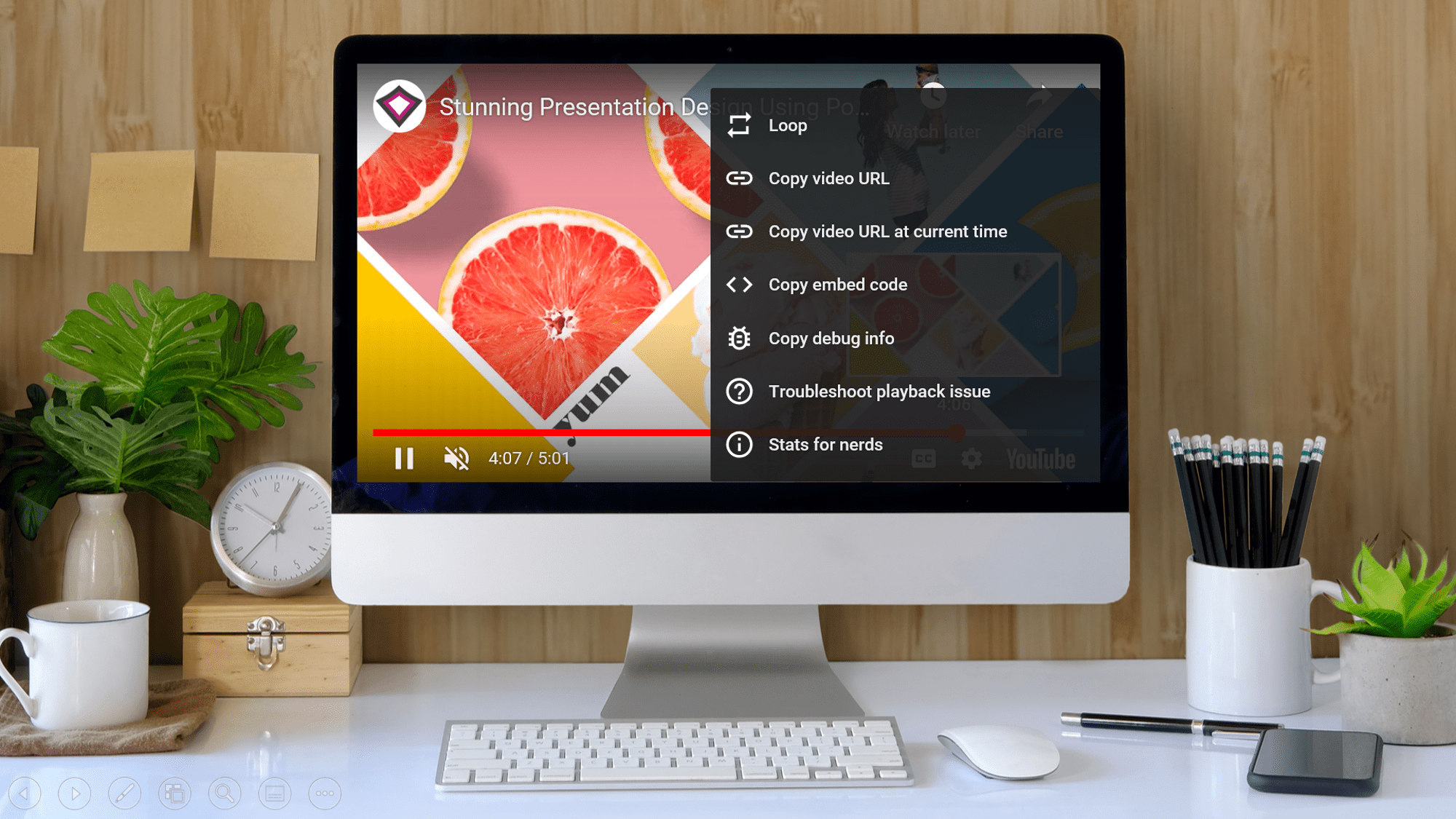
It may be stating the blindingly obvious, but you have to be online to make this option work. Even when presenting. PowerPoint will not store or buffer the video for you. And, frankly, I’ve had instances where the video just fails to play – even with a good Wi-Fi connection and YouTube playing in a browser.
Oh, and when you open a presentation with an embedded YouTube video, you’ll get a security warning about external media objects, which may put some people off. You also have to remember to click the Enable Content button in the yellow warning message at the top of your PowerPoint screen, otherwise your video won’t play.
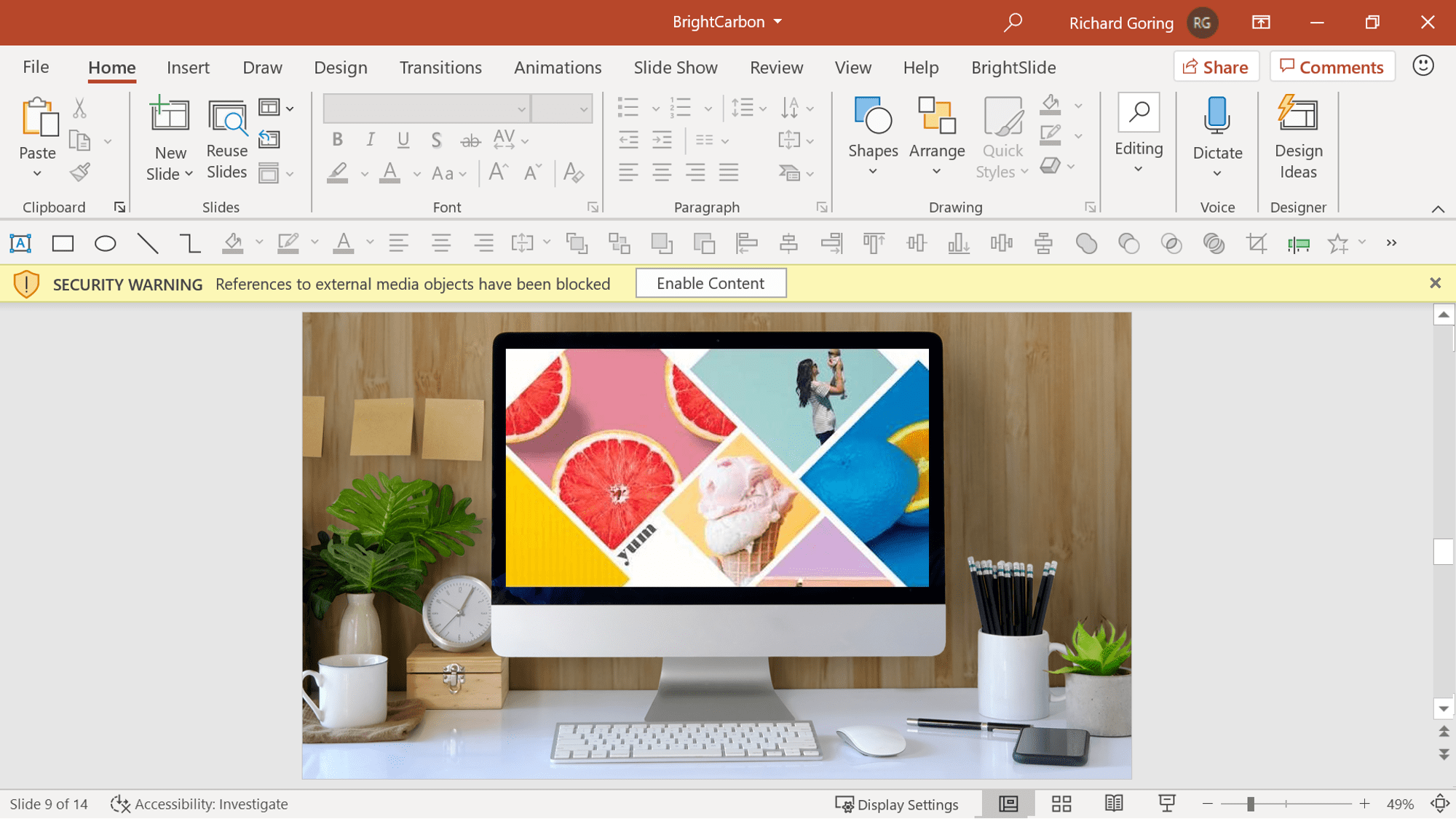
Another reliability issue with this option is just what online video sources you can insert from. YouTube almost always seems to work, which is fair enough given that it’s such a huge site. Most of what you want will be there. But I’ve had trouble with Vimeo in the past, which is where a lot of companies add their video content as it gives you more control over the video branding and use. And sites like Metacafe and dailymotion don’t appear to work at all. And no, sadly you can’t insert Netflix video into PowerPoint either. Or Twitch. It’s also worth noting that you have to put a direct link to the video when trying to insert it into PowerPoint. If there is a YouTube video embedded on another site, you have to add the YouTube URL into PowerPoint, not the other site’s URL. In some of these cases you can get around the issue by having a hyperlink to the video or site you want, which opens in a browser, but it’s not elegant.
One option is to try to download the online video so you have a local copy, and you can then embed video into PowerPoint from your computer. This also gives you more reliable playback as you’re not beholden to a dodgy Wi-Fi connection. Sites like y2mate work pretty well for this, but remember that most online video sites don’t want you to download videos – it’s against their terms of service and it’s likely infringing copyright. As with everything, just because it’s possible doesn’t mean you should do it. But you may find some channels that allow it.
In an ideal world, you’d embed a video into PowerPoint because, frankly, it’s the best option for playback and reliability and it’s crazy to do anything else. But it does mean that your presentation file size becomes huge, as the video is part of the deck. Embedding YouTube video into PowerPoint is nice because it gives you lots of choice, but you need to be online and you’re limited with playback and formatting options.
If you need to minimize file size, but don’t want to use YouTube, there are way to compress video and reduce file size, but another option is to insert a linked video in PowerPoint instead. This means that the video file is separate to the PowerPoint file, so doesn’t add to the file size, but you open yourself to a world of frustration if you don’t get things right.
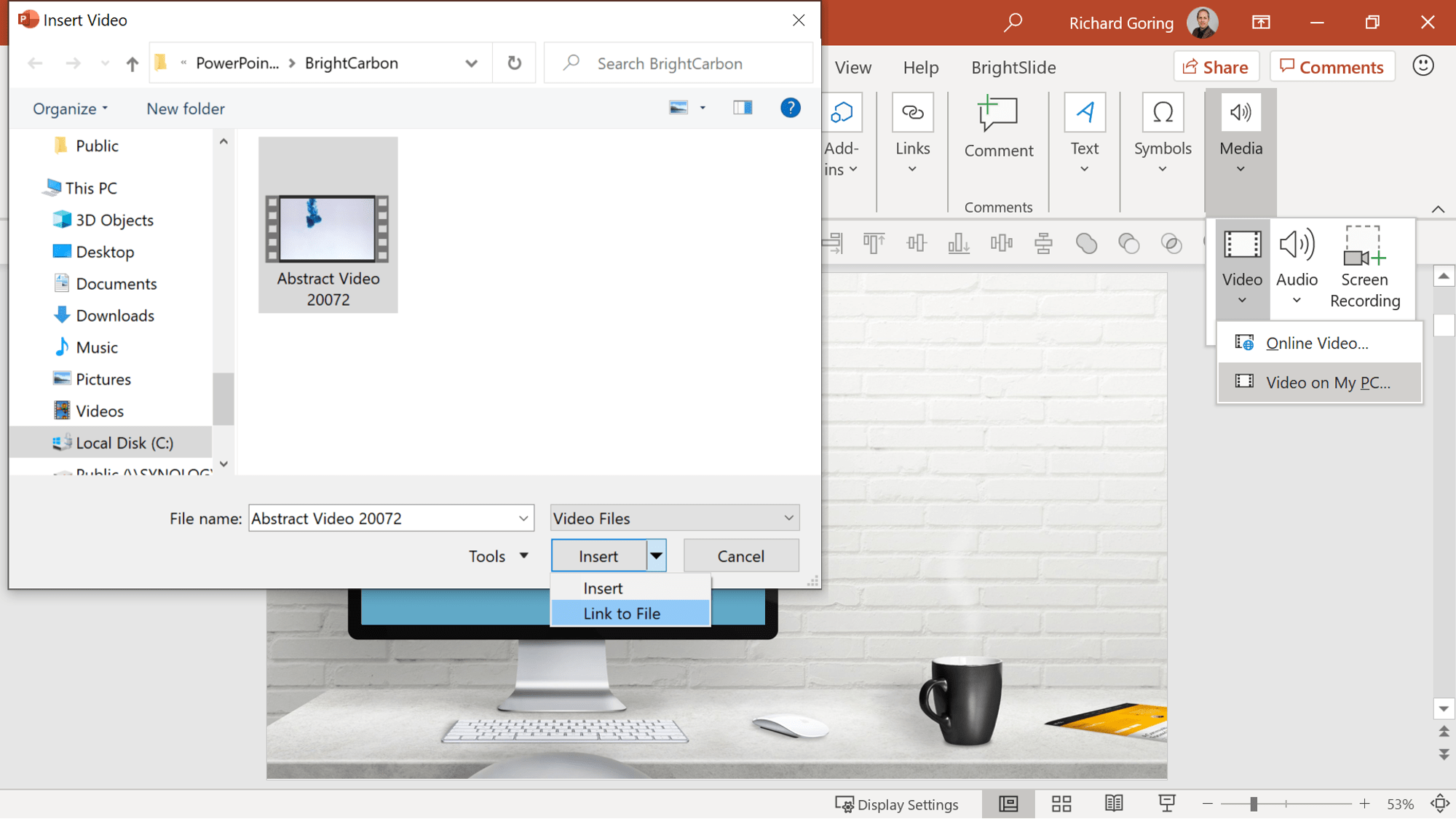
What’s the process for how to link a video in PowerPoint? Go to the Insert tab on the ribbon, and Video on the right as with any video. Choose Insert Video on My PC, and find the video you want. Instead of clicking the Insert button at the bottom of the window, choose the drop-down arrow next to it and you’ll see an option to Link to File. Click that, and now you have a linked video file that doesn’t eat up your file size. It can be treated in exactly the same way as all the other techniques with an embedded video, for formatting, editing, and playing, but there are a couple of critical things to note.
First, this is a linked video, not embedded, so if you share your PowerPoint file with others, they don’t get the video (which you may want). All they’ll see is the poster frame, but they’ll get an error message if they try to play it.
Next, as it’s linked, PowerPoint will go looking for the video file to play it. If you’re doing this from a network drive, you need to ensure that you have sufficient bandwidth for smooth playback, and even then there may be a delay in the video starting to play, which is annoying, or may even cause you to click again and then skip past it entirely.
And then you have to consider file management. If the video file moves to a different folder, the file name changes, or the linked file path is different in anyway way (for example a system admin makes a change to the network structure), then the video won’t work. PowerPoint is looking for a specific file path to follow, which doesn’t get automatically updated if something changes.
A way around this is to have the video file in the same folder as the presentation when you insert the video link. That way, the folder structure and file path can change, because PowerPoint just looks in the same folder as the presentation. This is much safer, but the delay in playing from a network drive and need to have sufficient bandwidth still apply.
Oh, and you want to share your deck with others? If the linked video is in the same folder as the presentation, then as long as it’s still in the same folder as the presentation on someone else’s computer, then everything will play fine. But, good luck explaining all these parameters to someone and having them get it right every single time. You still have to share a large file with them – but it’s a video file rather than a PowerPoint deck – so you’re far better off embedding the video for the reliability that it brings, rather than run the risk of a Media Not Found error message when you’re on stage or in front of clients.
Leave a commentWithout a proper PowerPoint template, presentations can be a bit of a mess. Here are the building blocks for developing a PowerPoint template that works!
By applying some key principles of presentation design, you can make your PowerPoint design really standout and deliver both a more ‘popping’, but also more effective presentation.
Most presentations are a cascade of text-heavy Death-by-PowerPoint slides. Online learners suffer the torture of brochures converted to click-through-eLearning. Most people now recognize that using visuals is the way to go. But how do you make visual presentations and eLearning that work? We think there are six steps you need to follow.
Join the BrightCarbon mailing list for monthly invites and resources
Tell me more!It provides us with powerful presentation material to use again and again. This helps us get our message across and enhances our professional image.
Joe Critchley Trade Extensions

I did try to embed a video in my presentation and two things happened.
1. The YouTube video did not come over. I did check the URL.
2. On a second one I was able to embed it, but when I was in presentation mode I struggled to get back to the presentation.
Please advise.
Hi Lorene,
There could be a few things wrong with trying to embed. First, when did you do this? YouTube had a global outage the other day. It’s worth checking to see if the video plays directly on YouTube (there could be geographical restrictions too). If it does, it should be OK in PowerPoint.
Second, what version of PowerPoint are you using? PowerPoint 2010 may have issues at the moment as it used a Flash-based embed tool, which has now been discontinued. Although given that you got another video to play, this seems less likely. Could you share the URL (info@brightcarbon.com) and we’ll try it?
When you’re playing the second video how are you trying to move on and get back to the presentation? The default with YouTube videos is that if you click your mouse cursor on them it will play/pause the video, and so you either have to click outside the video or use the up/down left/right arrow keys to navigate to the next slide. Does that help?
This is interesting site. Please, share it more!
Hi, I’m able to embed a youtube video into my powerpoint however it (the video) presents itself black. I can still double click on it and it will play but for presentation it looks out of place and not enticing for students learning.
Your step-by-step guide on how to embed a YouTube video in PowerPoint is incredibly helpful. The clear instructions and accompanying screenshots made the process so easy to follow. This is going to be a game-changer for my presentations. Thank you for sharing such valuable information!